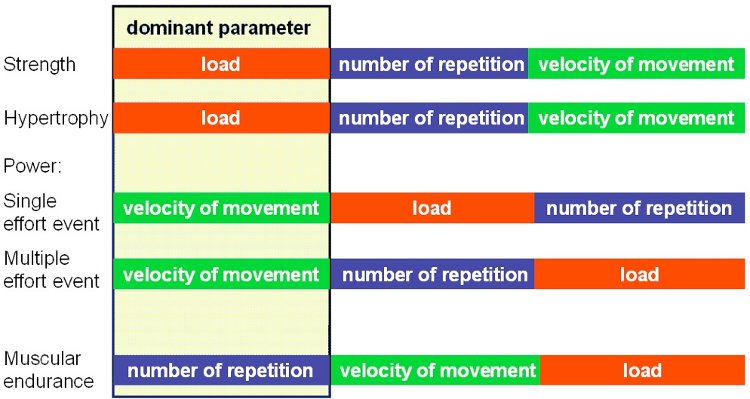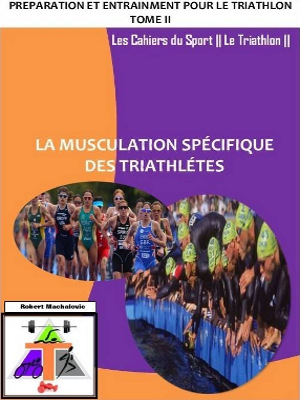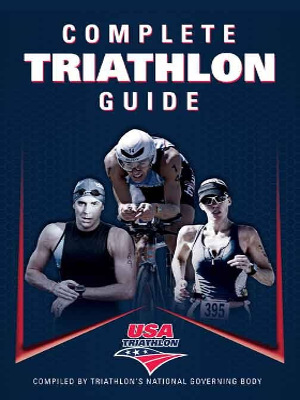Reactive strength is an ability to carry out muscle performance in motor activities which use stretch shortening cycle (SSC) with duration up to 200ms from beginning.
Endurance strength is manifested by repeated overcoming relatively low resistance at slow speed and multiple cyclic movements (e.g. cross-country skiing, sculling etc.)
The above abilities are related to focus and effect of strength training. Among the most important effects of strength training, there are:
- Strength development
- Muscle hypertrophy development
- Net power output development at acyclic movement
- Net power output development at cyclic movement
- Muscle endurance development
Strength development is understood as an improvement in absolute or relative values of overcome external resitance at constant number of repetitions for specific muscle groups or exercises.
Muscle hypertorphy development represents increase in crosscut of active muscle fibre.
Net power output development at acyclic movement means improvement of optimum combination of speed of applied strength for dominant muscle groups in specific motor activities.
Net power output development at cyclic movement means improvement of optimum combination of speed of applied strength for dominant muscle groups in specific motor activities for a necessarilly long period.
Muscle endurance development represents improvement in strength manifestation of specific muscle groups in activities that last for a relatively long period without declining intensity.
Each manifestation of dynamic strength is different in its specific parameters. It is possible to differentiate among three essential specific parameters:
- Size of resistence
- Number of repetitions
- Velocity of movement
In any strength manifestation, one of the parameters is always dominant. The relationship among specific parameters with regard to the effects of strength training is presented in Figure.

Relationship among specific parameters with regard to the effects of strength training.
Development of strength and hypertrophy are close to maximal strength characteristics. Net power output development at acyclic movement is similar to explosive strength characteristics and net power output development at cyclic movement is close to fast strength. Muscle endurance development is similar to endurance strength characteristics.
Methods of strength development
Method of strength development arise from the above statements. There are many criteria for classifying individual methods of strength development. For the needs of this paper, we have chosen a classification which follows the criterion of the size of the resistance which is being overcome and velocity of the movement of specific muscle group which is being performed. Figure presents an overview of the methods.

Overview of methods of strength development
Method of maximal effort is based on overcoming nearly limit resistance at slow speed in sets with small number of repetitions (usually 1-3x).
Method of breakes of movement is based on braking over-maximal resistance at a speed as low as possible in sets of one repetition.
Method of repeated effort is based on overcoming big but under-limit resistance at slow speed in sets with different numbers of repetitions (usually 8-12x). Very often, subsequent sets with either increasing or decreasing number of repetitions are used (so-called pyramids).
Intermediate method is based on combination of static and dynamic contraction. During the movement of a specific exercise (weight squat) the movement is stopped for several times (2-4x, static contraction).
Method of speed is based on overcoming low resistance at maximum speed possible in sets with different numbers of repetitions (usually 3-8).
Plyometric method is based on the principle of stretch shortening cycle in which accumulated elastic energy is used for subsequent excentric contraction. As a rule, the weight of own body is used in sets of 2-5 repetitions.
Method of strength endurance is based on overcoming low resistance at relatively slow speed with a big number of repetitions (usually < 15x). This method is often applied in the form of circular operation.
Creating a Training Program
Creating a program of strength training is a complex process which results from the following sequence of actions:
- Needs analysis
- Exercise selection
- Training frequency
- Exercise order
- Training loads and repetitions
- Volume
- Rest periods
Step 1: Needs analysis
Evaluation of the Sports
The first task in a needs analysis is to determine the unique characteristic of the sport. This task includes consideration of the following attributes of the sport:
- Body and limb movement patterns and muscular involvement (movement analysis).
- Strength, power, hypertrophy, and muscular endurance priorities (physiological analysis).
- Common sites for joint and muscle injury and causative factors (injury analysis).
Training status of the Athlete
An athlete current condition or level of preparedness to begin a new or revised program (training status) is an important consideration when designing training programs. An assessment of the athlete’s training background should examine the:
- type of training program (sprint, plyometric, resistance, etc.)
- length of recent regular participation in previous training program(s)
- level of intensity involved in previous training program(s) and
- degree of exercise technique experience (i.e., the knowledge and skill to perform resistance training exercises properly)
Example of Classifying Resistance Training Status
| Resistance Training Background | |||||
| Resistance training status | Current program | Training age | Frequency (per week) | Training stress | Technique experience and skill |
|---|---|---|---|---|---|
| Beginner (untrained) | Not training or just began training | <2 months | ≤1-2 | None or low | None or minimal |
| Intermediate (moderately resistance-trained) | Currently training | 2-6 months | ≤2-3 | Medium | Basic |
| Advanced (well resistance-trained) | Currently training | ≥1 years | ≥3-4 | High | High |
Primary Resistence Training Goal
The athlete’s test results, the movement and physiological analysis of the sport and the priorities of the athlete’s sport season determine the primary goal or outcome for resistance training program. An example of how the strength and conditioning professional may prioritize the resistance training emphases during the four main sport seasons is shown in table.
Example of General Training Priorities by Sport Season
| PRIORITY GIVEN TO | |||
| Sport season | Sport practice | Resistance training | Resistance training goal |
|---|---|---|---|
| Off-season | Low | High | Hypertrophy and muscular endurance (initially);strength and power (later) |
| Preseason | Medium | Medium | Sport and movement specific (i.e., strength, power, or muscular endurance, depending on the sport) |
| In-season | High | Low | Maintenance of preseason training goal |
| Postseason (active rest) | Variable | Variable | Not specific (may include activities other than sport skill or resistance training) |
Step 2: Exercise Selection
Exercise selection involves choosing exercises for a resistance training program.
Exercise Type (Core and Assistance Exercises)
Exercise can be classified as either core or assistance based on the size of the muscle areas involved and their level of contribution to particular sport movement. Core exercises recruit one or more large muscle areas (i.e., chest, shoulder, back, hip, or thigh), involve two or more primary joints (multijoint exercises) for example power clean, and receive priority when one is selecting exercise because of their direct application to the sport. Assistance exercises usually recruit smaller muscle areas (i.e., upper arm, abdominals, calf, neck, forearm, lower back, or anterior lower leg), involve only one primary joint (single-joint exercise) for example bench press, and considered less important to improving sport performance.
Sport-Specific Exercises
The exercises selected for a resistance training program that focus on conditioning for a particular sport need be similar to the activities of that sport in their body and limb movement patterns, joint ranges of motion, and muscular involvement. Table provides examples of resistance training exercises that relate in varying degrees to the movement patterns of various sports.
Examples of Movement-Related Resistance Training Exercises
| Movement pattern | Related exercises |
|---|---|
| Ball dribbling and passing | Close-grip bench press, dumbbell bench press, triceps pushdown, reverse curl |
| Ball kicking | Unilateral hip adduction and abduction, forward step lunge, knee extension, leg raise |
| Freestyle swimming | Lat pulldown, lateral shoulder raise, forward step lunge, upright row, barbell raise |
| Jumping | Power clean, push jerk, back squat, front squat, standing calf (heel) raise |
| Racket stroke | Flat dumbbell fly, bent-over lateral raise, wrist extension |
| Rowing | Power clean, bent over row, seated row, hip sled, horizontal leg press, deadlift |
| Running, sprinting | Forward step lunge, step-up, knee extension, knee curl, toe raise (dorsiflexion) |
| Throwing, pitching | Barbell pullover, overhand triceps extension, shoulder internal and external rotation |
Muscle Balance
Exercises selected for specific needs of sports discipline should mainten balance of muscle strength between opposing muscle groups (e.g. biceps brachii a triceps brachii). While building a strength program, it is necessary to do it with regard to balanced strength development. Unbalanced strength development may lead to muscle disbalance (e.g. as it happens with disbalance between quadriceps and hamstrings).
Step 3: Training Frequency
Training frequency refers to the number of training sessions completed in a given time period. For a resistance training program, a common time period is one week.
Training status
The athlete’s level of preparedness for training, which was determined during the step 1, is an influential factor in determining training frequency because it affects the number of rest days needed between training sessions. Traditionally, three workouts per week are recommended for many athletes, as the intervening days allow sufficient recovery between sessions. As an athlete adapts to training and becomes better conditioned, it is appropriate to consider increasing the number of training days (see table ).
Resistance Training Frequency Based on Training Status
| Training status | Frequency guidelines (session per week) |
|---|---|
| Beginner | 2-3 |
| Intermediate | 3-4 |
| Advanced | 4-7 |
More highly resistance-trained (intermediate or advanced) athletes can augment their training by using a split routine in which different muscle groups are trained on different days (see table ).
Examples of Common Split Routines
| Day | Body parts or muscle groups trained | Su | M | Tu | W | Th | F | Sa | Resulting training frequency |
|---|---|---|---|---|---|---|---|---|---|
| 1 | Lower body | Rest | Lower body | Upper body | Rest | Lower body | Upper body | Rest | 4 times per week |
| 2 | Upper body | ||||||||
| 1 | Chest, shoulders, triceps | Rest | Chest, shoulders, triceps | Lower body | Back, trapezius, biceps | Chest, shoulders, triceps | Rest | Lower body | 5 times per week |
| 2 | Lower body | ||||||||
| 3 | Back, trapezius, biceps |
Sport Season
Another influence on resistance training frequency is the sport season. For example, the increased emphasis on practicing the sport skill during the in-season necessitates a decrease in the time spent in the weight room and, consequently, reduces the frequency of resistance training (see table).
Resistance Training Frequency Based on the Sport Season
| Sport season | Frequency guidelines (session per week) |
|---|---|
| Off-season | 4-6 |
| Preseason | 3-4 |
| In-season | 1-3 |
| Postseason (active rest) | 0-3 |
Step 4: Exercise order
Exercise order refers to a sequence of resistance exercises performed during one training session. Although there are many ways to arrange exercises, decision are invariably based on how one exercise affect the quality of effort or the technique of another exercise. Usually exercises are arranged so that an athlete’s maximal force capabilities are available to complete a set with proper exercise technique. Four most frequent approaches to exercise order in strenght training.
Power, Other Core, Then Assistance Exercises
Exercises for developing net power output such as the snatch, hang clean, power clean, and push jerk should be employed first during training. Only then, should there come other core exercises followed by assistance exercises. Of all these, exercises for developing net power output require the highest level of skill and concentration and they tend to be most affected by fatique. Once athletes start to be tired, they are more likely to use wrong technique and they are therefore subject to a higher risk of injury.
Upper and Lower Body Exercises (Alternated)
One method of providing the opportunity for athletes to recover more fully between exercises is to alternate upper body exercises with lower body exercises. This arrangement is especially helpful for untrained individuals who find that completing several upper or lower body exercises in succession is too strenuous. Also, if training time is limited, this method of arranging exercises minimizes the rest periods required between exercises and maximized the rest between body areas. If the exercises are performed with minimal rest periods (20-30 seconds), this method is also referred to as circuit training.
"Push" and "Pull" Exercises (Alternated)
Another method of improving recovery and recruitment between exercises is to alternate pushing exercise (e.g., bench press, shoulder press, and triceps extension) with pulling exercises (e.g., lat pulldown, bent-over row, biceps curl). This push-pull arrangement ensures that the same muscle groups will not be used in two exercises (or sets, in some cases) in succession, thus reducing fatigue in the involved muscles. The alternation of push and pull is also used in circuit training programs and is an ideal arrangement for athletes beginning or returning to a resistance training program.
Supersets and Compound Sets
Other methods of arranging exercises involve having athlete perform one set of a pair of exercises with little to no rest between them. Two common examples are referred to as super sets and compound sets. A superset involves two sequentially performed exercises that stress two opposing muscles or muscles areas (i.e., agonist and its antagonist). For example, an athlete perform 10 repetitions of barbell biceps curl exercise, sets bar down, then goes over to the triceps pushdown station and performs 10 repetitions. A compound set involves sequentially performing two different exercises for the same muscle group.
Step 5: Training Load and Repetition
Load is most simply referred to as the amount of weight assigned to an exercise set and is often characterized as the most critical aspect of a resistance training program.
Relationship between Load and Repetitions
The number of times an exercise can be performed (repetitions) is inversely related to the load lifted; the heavier the load, the lower the number of repetitions that can be performed. Load is commonly describes as either a certain percentage of a 1-repetition maximum (1 RM) - the greatest amount of weight that can be lifted with proper technique for only one repetition-or the most weight lifted for a specified number of repetitions, a repetition maximum (RM). For instance, if an athlete can perform 10 repetitions with 60 kg in the back squat exercise, her 10RM is 60 kg. It is assumed that the athlete provided a maximal effort. Table shows the relationship between a submaximal load calculated as a percentage of the 1RM-and the number of repetitions than can be performed at that load. By definition, 100% of the 1RM allows the athlete to perform one repetition.
Percent of the 1RM and Repetitions Allowed (%1RM-Repetition Relationship)
| %1RM | Number of repetitions allowed |
|---|---|
| 100 | 1 |
| 95 | 2 |
| 93 | 3 |
| 90 | 4 |
| 87 | 5 |
| 85 | 6 |
| 83 | 7 |
| 80 | 8 |
| 77 | 9 |
| 75 | 10 |
| 70 | 11 |
| 67 | 12 |
| 65 | 15 |
1RM and Multiple-RM Testing Option
To gather information needed to assign a training load, the strength and conditioning professional has the option of determining athlete’s:
- Actual 1RM (directly tested)
- Estimated 1RM from a multiple-RM test (e.g., a 10RM) , or
- Multiple RM based on the number of repetitions planned for that exercise (the "goal" repetitions; e.g., five repetitions per set)
Once the actual 1RM is measured or estimated, the athlete’s training load is calculated as a percentage of the 1RM. Alternatively, a multiple-RM test may be performed based on goal repetitions, thereby eliminating computations or estimations. In many cases, the strength and conditioning professional will use a variety of testing option depending on exercises selected and the athlete’s training background. A common strategy for testing sufficiently conditioned athletes is to conduct a 1RM test in several core exercises and use multiple-RM testing for assistance exercises.
Testing the 1RM
This method of assessment is typically reserved for resistance trained athletes who are classified as intermediate or advanced and have exercise technique experience in the exercises being tested. Individuals who are untrained, inexperienced, injured, or medically supervised may not be appropriate participants for 1RM testing.
1RM testing protocol
- Instruct the athlete to warm up with a light resistance that easily allows 5 to 10 repetitions.
- Provide a 1-minute rest period.
- Estimate a warm-up load that will allow the athlete to complete three to five repetitions by adding:
- 4-9 kg or 5% to 10% for upper body exercise or,
- 14-18 kg or 10% to 20% for lower body exercise.
- Provide a 2-minute rest period.
- Estimate a conservative, near-maximal load that will allow the athlete to complete two to three repetitions by adding:
- 4-9 kg or 5% to 10% for upper body exercise or,
- 14-18 kg or 10% to 20% for lower body exercise.
- Provide a 2 to 4 minute rest period.
- Make a load increase:
- 4-9 kg or 5% to 10% for upper body exercise or,
- 14-18 kg or 10% to 20% for lower body exercise.
- Instruct the athlete to attempt a 1RM.
- If the athlete was successful, provide a 2 to 4 minute rest period and go back to step 7.
If the athlete failed, provide a 2 to 4 minute rest period, then decrease the load by subtracting:
- 4-9 kg or 5% to 10% for upper body exercise or,
- 14-18 kg or 10% to 20% for lower body exercise.
AND then go back to step 8.
Continue increasing or decreasing the load until the athlete can complete one repetition with proper exercise technique. Ideally, the athlete’s 1RM will be measured within three to five testing sets.
Estimating a 1RM
When maximal strength testing is not warranted, testing with a 10RM load (and then estimating or predicting the 1RM) can be a suitable secondary option. The protocol for 10RM is similar to that for 1RM testing, bat each set requires 10 repetitions, not one.
Multiple-RM Testing Based on Goal Repetitions
A third option for determining training loads requires the strength and conditioning professional to first decide the number of repetition (i.e., the goal repetitions) the athlete will perform in the actual program for the exercise being tested. For example, if the strength and conditioning professional decides that the athlete should perform six repetitions for the bench press exercise in the training program, the multiple/RM testing protocol should have will result in six repetitions (6RM).
Assigning Load and Repetitions Based on the Training Goal
The training goal is attained when the athlete lifts a load of a certain percentage of the 1RM for specific number of repetitions. The number of repetitions and percentage of the 1RM shows table.
Load and Repetition Assignments Based on the Training Goal
| Training goal | Load (%)RM | Goal repetitions |
|---|---|---|
| Strength | >85 | <6 |
| Power: Single-effort event | 80-90 | 1-2 |
| Power: Multiple-effort event | 75-85 | 3-5 |
| Hypertrophy | 67-85 | 6-12 |
| Muscular endurance | <67 | >12 |
Variation of the Training Load
If the athlete can perform two or more repetitions over his or her assigned repetition goal for a given exercise in the last set in two consecutive workouts, weight should be added to that exercise for next training session. For example, strength and conditioning professional assigns three sets of 10 repetitions in the bench press exercise and the athlete performs all 10 repetitions in all set. After several workout sessions, the athlete is able to complete 12 repetitions in third (last) set for two consecutive workouts. In the following training, the load for that exercise should be increased. Examples of load increases shows table (for training programs with load volumes of approximately three sets of 5 to 10 repetitions).
Examples of Load Increases
| Description of the athlete | Body area exercise | Estimated load increase |
|---|---|---|
| Smaller, weaker, less trained | Upper body | 1-2 kg |
| Lower body | 2-4 kg | |
| Larger, stronger, more trained | Upper body | 2-4+ kg |
| Lower body | 4-7+ kg |
Step 6: Volume
Volume is to the total amount of weight lifted in a training session, and a set is a group of repetitions sequentially performed before the athlete stops to rest. Repetition-volume is the total number of repetitions performed during a workout session, and load-volume is the total number of set then multiplied by the weight lifted per repetition. For example, the load-volume for two sets of 10 repetitions with 50 kg would be expressed as 2 x 10 x 50 kg. Training volume is directly based on the athlete’s resistance training goal. Table provides a summary of guidelines for the number of repetitions and sets commonly associated with strength, power, hypertrophy, and muscular endurance training programs.
Volume Assignments Based on the Training Goal
| Training goal | Goal repetitions | Sets |
|---|---|---|
| Strength | <6 | 2-6 |
| Power: Single-effort event | 1-2 | 3-5 |
| Power: Multiple-effort event | 3-5 | 3-5 |
| Hypertrophy | 6-12 | 3-6 |
| Muscular endurance | >12 | 2-3 |
Step 7: Rest Period
The time dedicated to recovery between sets and exercises is called the rest period or interest rest. The length of the rest period between sets and exercises is highly dependent on the goal of training, the relative load lifted, and the athlete’s training status (if the athlete is not in good physical condition, rest period initially may need to be longer than typically assigned). The recommended rest period lengths for strength, power, hypertrophy, and muscular endurance programs are shown in table .
Rest Period Length Assignments Based on The Training Goal
| Training goal | Rest period length |
|---|---|
| Strength | 2-5 minutes |
| Power: Single-effort event | 2-5 minutes |
| Power: Multiple-effort event | 2-5 minutes |
| Hypertrophy | 30 seconds-1.5 minutes |
| Muscular endurance | ≤ 30 seconds |

 The ability to resist external resistance with muscle contraction represents a basic principle of developing the complex of strength ability. Muscle contraction is conditioned by many factors. If there is no visible movements of body segments during muscle contraction, this is referred to as static strength (e.g. holding tim in squat when thighs are held horizontally to the ground). On the other hand, if muscle contraction causes a visible movement of body segments by stretching (excentric muscle contraction) or by shortening the muscle (concentric muscle contraction), it is referred to as dynamic strength (e.g. mutual movement of forearm and upper arm during benchpress exercise). The dynamic strength can further be divided into partial manifestations of dynamic strength:
The ability to resist external resistance with muscle contraction represents a basic principle of developing the complex of strength ability. Muscle contraction is conditioned by many factors. If there is no visible movements of body segments during muscle contraction, this is referred to as static strength (e.g. holding tim in squat when thighs are held horizontally to the ground). On the other hand, if muscle contraction causes a visible movement of body segments by stretching (excentric muscle contraction) or by shortening the muscle (concentric muscle contraction), it is referred to as dynamic strength (e.g. mutual movement of forearm and upper arm during benchpress exercise). The dynamic strength can further be divided into partial manifestations of dynamic strength:


